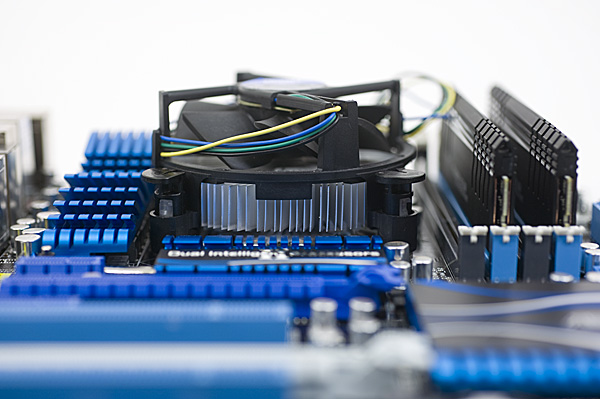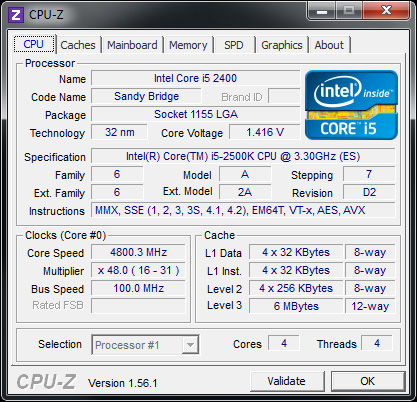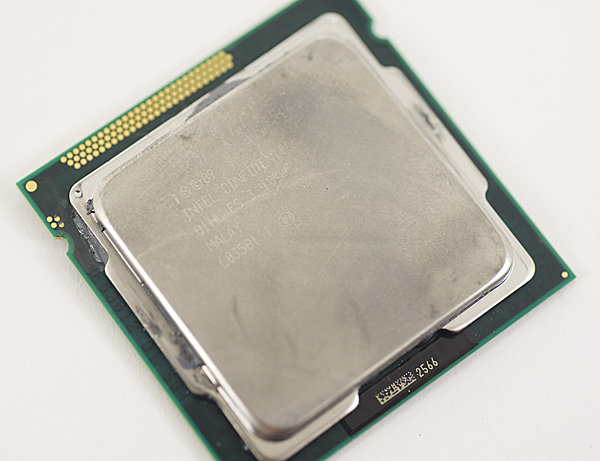The Sandy Bridge Review: Intel Core i7-2600K, i5-2500K and Core i3-2100 Tested
by Anand Lal Shimpi on January 3, 2011 12:01 AM ESTOverclocking, the K-Series and What You’ll Want to Buy
If you haven’t noticed, the computing world is becoming more integrated. We review highly integrated SoCs in our smartphone coverage, and even on the desktop we’re seeing movement towards beefy SoCs. AMD pioneered the integrated memory controller on desktop PCs, Intel followed suit and with Lynnfield brought a PCIe controller on-die as well. Sandy Bridge takes the next logical step and brings a GPU on-die, a move matched by AMD with Brazos and Llano this year.
In the spirit of integration, Intel made one more change this round: the 6-series chipsets integrate the clock generator. What once was a component on the motherboard, the PLL is now on the 6-series chipset die. The integrated PLL feeds a source clock to everything from the SATA and PCIe controllers to the SNB CPU itself. With many components driven off of this one clock, Intel has locked it down pretty tight.
With Nehalem and Westmere, to overclock you simply adjusted the BCLK from 133MHz to whatever speed you wanted and sometimes toyed with multipliers to arrive at a happy end result. With Sandy Bridge, the BCLK generated on the 6-series PCH is at 100MHz by default and honestly won’t go much higher than that.
While I’ve heard reports of getting as high as 115MHz, I’d view 103—105MHz as the upper limit for what you’re going to get out of BCLK overclocking. In other words: next to nothing. A 105MHz BCLK overclock on a Core i7-2600 will take you from a stock speed of 3.4GHz to a whopping 3.57GHz. The form of overclocking we’ve been using for the past decade is effectively dead on Sandy Bridge.
Years ago, before the Pentium II, we didn’t rely on BCLK (or back then it was just FSB or bus overclocking) to overclock. Back then, if we wanted a faster CPU we’d just increase the clock multiplier. Intel has dabbled in offering multiplier unlocked parts for overclockers, we saw this last year with the Core i7 875K for example. With Sandy Bridge, those unlocked parts are going to be a lot more important to overclockers.
It works like this. If you have a part that does not support Turbo (e.g. Core i3-2100 series), then your CPU is completely clock locked. You can’t overclock it at all, have fun at your stock frequency. This is good news for AMD as it makes AMD even more attractive at those price points.
If you have a part that does support turbo (e.g. Core i5-2400), then you have what’s called a “limited unlocked” core—in other words you can overclock a little bit. These parts are limited to an overclock of 4 processor bins above and beyond the highest turbo frequency. Confused yet? This chart may help:
In this case we’re looking at a Core i5-2500, which runs at 3.3GHz by default. When a single core is active, the chip can turbo up to 3.7GHz. If you want, you can change that turbo state to go as high as 4.1GHz (if your CPU and cooling can keep up).
Overclocking these limited unlocked chips relies entirely on turbo however. In the case above, the fastest your chip will run is 4.1GHz but with only one core active. If you have four cores active the fastest your chip can run is 3.8GHz. While Intel didn’t sample any limited unlocked parts, from what I’ve heard you shouldn’t have any problems hitting these multiplier limits.
There’s a third class of part: a fully unlocked K-series chip. At launch there are only two of these processors: the Core i5-2500K and the Core i7-2600K. Anything with a K at the end of it means you get all multipliers from 16x all the way up to 57x at your disposal. It’s effectively fully unlocked.

These chips overclock very well. Both my Core i5-2500K and Core i7-2600K hit ~4.4GHz, fully stable, using the stock low-profile cooler.

This is all you need for 4.4GHz
With a bit more effort and a better cooler, you can get anywhere in the 4.6-5.0GHz range:

It's a bit too early to tell how solid these near-5GHz overclocks will be, but I'm confident in the sub-4.5GHz overclocks we were able to sustain.
You do pay a price premium for these K-series SKUs. The 2500K will cost you another $11 over a stock 2500 and the 2600K costs an extra $23. In the case of the 2500K, that’s a small enough premium that it’s honestly worth it. You pay $11 extra for a chip that is very conservatively clocked and just begging for you to overclock it. Even the 2600K’s premium isn’t bad at all.
| Model Number | Standard SKU | K-Series SKU | Price Premium |
| Intel Core i7-2600 | $294 | $317 | +$23 |
| Intel Core i5-2500 | $205 | $216 | +$11 |
As an added bonus, both K-series SKUs get Intel’s HD Graphics 3000, while the non-K series SKUs are left with the lower HD Graphics 2000 GPU.
Compared to Lynnfield, you’re paying $11 more than a Core i5-760 and you’re getting around 10-45% more performance, even before you overclock. In a perfect world I’d want all chips to ship unlocked; in a less perfect world I’d want there to be no price premium for the K-series SKUs, but at the end of the day what Intel is asking for here isn’t absurd. On the bright side, it does vastly simplify Intel’s product stack when recommending to enthusiasts: just buy anything with a K at the end of it.
Since we’re relying on multiplier adjustment alone for overclocking, your motherboard and memory actually matter less for overclocking with Sandy Bridge than they did with P55. On both P67 and H67, memory ratios are fully unlocked so you can independently set memory speed and CPU speed. Even the GPU ratios are fully unlocked on all platforms and fully independent from everything else.












283 Comments
View All Comments
Kevin G - Monday, January 3, 2011 - link
There is the Z67 chipset which will allow both overclocking and integrated video. However, this chipset won't arrive until Q2.Tanel - Monday, January 3, 2011 - link
Well, yes, but one wonders who came up with this scheme in the first place. Q2 could be half a year from now.teohhanhui - Monday, January 3, 2011 - link
I've been thinking the same thing while reading this article... It makes no sense at all. Bad move, Intel.micksh - Monday, January 3, 2011 - link
Exactly my thoughts. No Quick Sync for enthusiasts right now - that's a disappointment. I think it should be stated more clearly in review.Another disappointment - missing 23.976 fps video playback.
has407 - Monday, January 3, 2011 - link
Yeah, OK, lack of support for VT-d ostensibly sucks on the K parts, but as previously posted, I think there may be good reasons for it. But lets look at it objectively...1. Do you have an IO-intensive VM workload that requires VT-d?
2. Is the inefficiency/time incurred by the lack of VT-d support egregious?
3. Does your hypervisor, BIOS and chipset support VT-d?
IF you answered "NO" or "I don't know" to any of those questions, THEN what does it matter? ELSE IF you answered "YES" to all of those questions, THEN IMHO SB isn't the solution you're looking for. END IF. Simple as that.
So because you--who want that feature and the ability to OC--which is likely 0.001% of the customers who are too cheap to spend the $300-400 for a real solution--the vendor should spend 10-100X to support that capability--which will thus *significantly* increase the cost to the other 99.999% of the customers. And that makes sense how and to whom (other than you and the other 0.0001%)?
IMHO you demand a solution at no extra cost to a potential problem you do not have (or have not articulated); or you demand a solution at no extra cost to a problem you have and for which the market is not yet prepared to offer at a cost you find acceptable (regardless of vendor).
Tanel - Tuesday, January 4, 2011 - link
General best practice is not to feed the trolls - but in this case your arguments are so weak I will go ahead anyway.First off, I like how you - without having any insight in my usage profile - question my need for VT-d and choose to call it "lets look at it objectively".
VT-d is excellent when...
a) developing hardware drivers and trying to validate functionality on different platforms.
b) fooling around with GPU passthrough, something I did indeed hope to deploy with SB.
So yes, I am in need of VT-d - "Simple as that".
Secondly, _all_ the figures you've presented are pulled out of your ass. I'll be honest, I had a hard time following your argument as much of what you said makes no sense.
So I should spend more money to get an equivalent retail SKU? Well then Sir, please go ahead and show me where I can get a retail SB SKU clocked at >4.4GHz. Not only that, you're in essence implying that that people only overclock because they're cheap. In case you've missed it it's the enthusiasts buying high-end components that enable much of the next-gen research and development.
The rest - especially the part with 10-100X cost implication for vendors - is the biggest pile of manure I've come across on Anandtech. What we're seeing here is a vendor stripping off already existing functionality from a cheaper unit while at the same time asking for a premium price.
If I were to make a car analogy, it'd be the same as if Ferrari sold the 458 in two versions. One with a standard engine, and one with a more powerful engine that lacks headlights. By your reasoning - as my usage profile is in need of headlights - I'd just have to settle with the tame version. Not only would Ferrari lose the added money they'd get from selling a premium version, they would lose a sell as I'd rather be waiting until they present a version that fits my needs. I sure hope you're not running a business.
There is no other way to put it, Intel fucked up. I'd be jumping on the SB-bandwagon right now if it wasn't for this. Instead, I'll be waiting.
has407 - Tuesday, January 4, 2011 - link
Apologies, didn't mean to come across as a troll or in-your-face idjit (although I admittedly did--lesson learned ). Everyone has different requirements/demands, and I presumed and assumed too much when I should not have, and should have been more measured in my response.You're entirely correct to call me on the fact that I know little or nothing about your requirements. Mea culpa. That said, I think SB is not for the likes of you (or I). While it is a "mainstream" part, it has a few too many warts..
Does that mean Intel "fucked up"? IMHO no--they made a conscious decision to serve a specific market and not serve others. And no, that "10-100X" is not hot air but based on costing from several large scale deployments. Frickin amazing what a few outliers can do to your cost/budget.
Akv - Monday, January 3, 2011 - link
I didn't have time to read all reviews, and furthermore I am not sure I will be able to express what I mean with the right nuances, since English is not my first language.For the moment I am a bit disappointed. To account for my relative coldness, it is important to explain where I start from :
1) For gaming, I already have more than I need with a quad core 775 and a recent 6x ati graphic card.
2) For office work, I already have more than I need with an i3 clarkdale.
Therefore since I am already equipped, I am of course much colder than those who need to buy a new rig just now.
Also, the joy of trying on a new processor must be tempered with several considerations :
1) With Sandy Bridge, you have to add a new mobo in the price of the processor. That makes it much more expansive. And you are not even sure that 1155 will be kept for Ivy Bridge. That is annoying.
2) There are always other valuable things that you can buy for a rig, apart from the sheer processor horsepower : more storage, better monitor...
3) The power improvement that comes with Sandy Bridge with what I call a normal improvement for a new generation of processors. It is certainly not a quantum leap in the nature of processors.
Now, there are two things I really dislike :
1) If you want to use P67 with a graphic card, you still have that piece of hardware, the IGP, that you actually bought and that you cannot use. That seems to me extremely unelegant compared to the 775 generation of processors. It is not an elegant architecture.
2) If you want to use H67 and the Intel IGP for office work and movies, the improvement compared to clarkdale is not sufficient to justify the buying of a new processor and a new mobo. With H67 you will be able to do office work fluently and watch quasi perfectly, with clarkdale you already could.
The one thing that I like is the improvement in consumption. Otherwise it all seems to me a bit awkward.
sviola - Monday, January 3, 2011 - link
Well, the IGP non being removable is like having on-board sound, but also having a dedicated soundcard. Not much of a deal, since you can't buy a motherboard withou integrated sound nowadays...Shadowmaster625 - Monday, January 3, 2011 - link
You say you want Intel to provide a $70 gpu. Well, here's a math problem for you: If the gpu on a 2600K is about 22% of the die, and the die costs $317 retail, then how much are you paying for the gpu? If you guessed $70, you win! Congrats, you now payed $70 for a crap gpu. The question is.... why? There is no tock here... only ridiculously high margins for Intel.